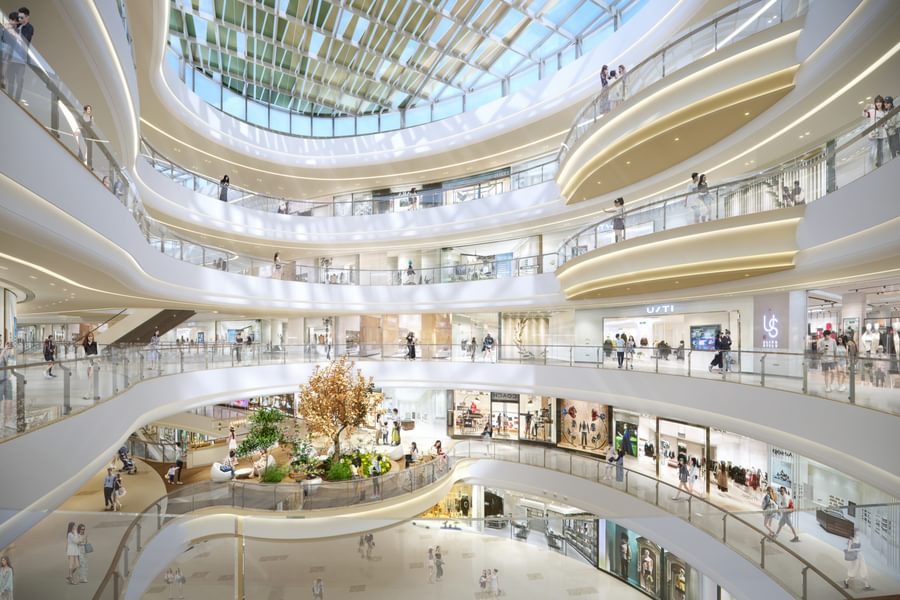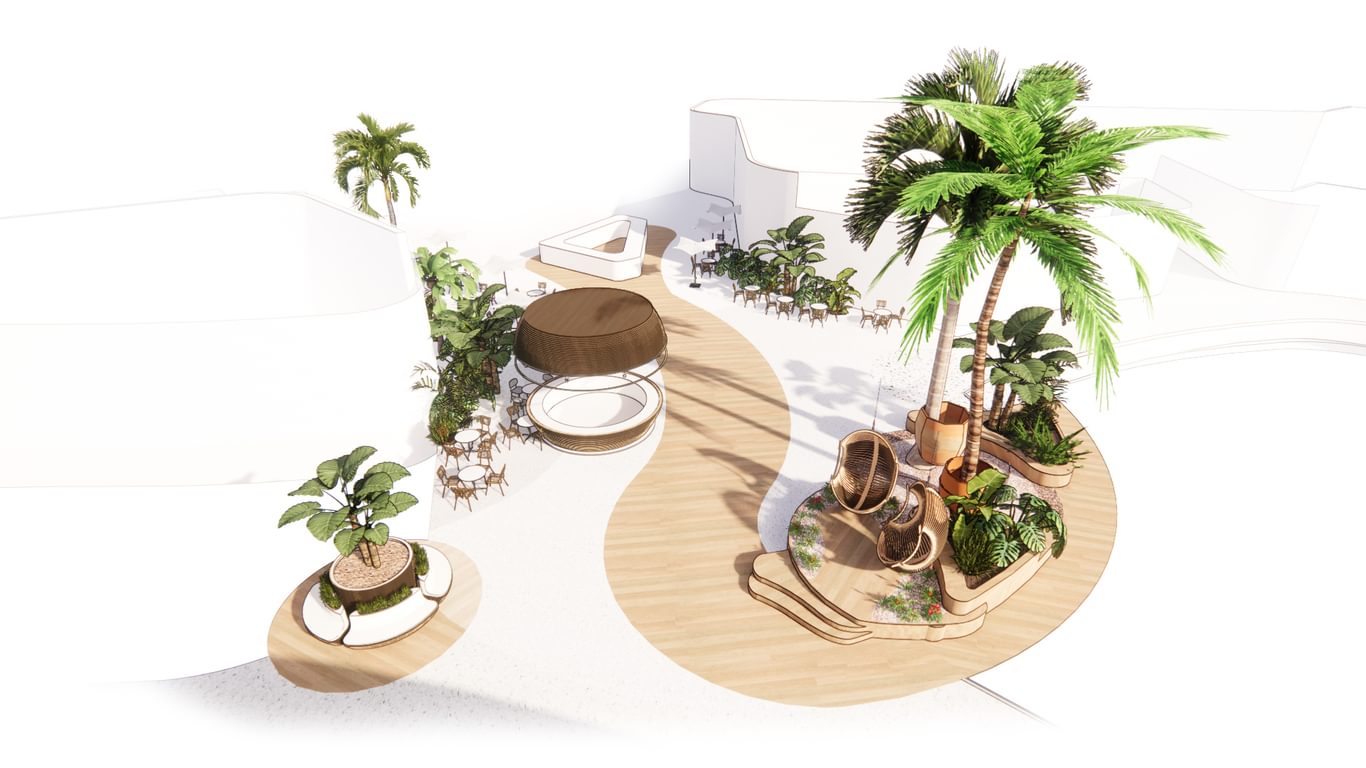
Nature-inspired shopping malls in China
Jessica Bernadetta, an interior designer in Chapman Taylor’s Shanghai studio, argues that people need a new kind of retail destination for a post-pandemic era. Nature-inspired shopping malls can promote a healthy lifestyle and encourage visitors to reduce their environmental footprint, whilst increasing their social horizons.
Pandemic-related shutdowns have accelerated the failure of many ‘bricks and mortar’ retailers, many of whom were already facing the challenge of the exponential growth of online shopping, which threatened to upend decades-old customer habits.
In China, after almost three years of restricted travel and limited opportunities, people are enjoying the chance to get outdoors again, whether to participate in activities, get closer to nature, or just experience a change of scenery. Significantly, they are also enjoying having some real-time ‘retail therapy’. It’s always essential for retail interior designers to understand people’s priorities and lifestyles. We believe people everywhere need a new kind of retail destination in the post-pandemic era.
Many mall owners have already embraced aspects of sustainability in their buildings’ fabric and management, but to survive (and thrive) during the next ‘new normal’ they must broaden their horizons further. We have previously written about the importance of biophilic design, working on the principle that humans evolved within the natural environment for millions of years, and that we are not well-adapted to the urban industrial environment that has been in existence for only the past 200 years or so. Nature-inspired shopping centres can be a positive influence, encouraging ecological responsibility whilst satisfying a need to get out-of-doors and build social connections whilst indulging in leisure activities and enjoying shopping and dining.
Promoting environmentally friendly spaces
Being environmentally friendly will attract more visitors, as people are increasingly motivated to make sustainable choices. By incorporating sustainability measures into the regular operation of shopping centres, we can reduce energy consumption and move closer to a more sustainable future.
Increasing the amount of natural light entering a retail centre has multiple positive outcomes, including lower energy costs and a more aesthetically beautiful layout (particularly when combined with additional plants). In tropical places, when natural light blends in with nature it can be an aesthetic way to embody an architectural local identity, as well as being more sustainable.
An important factor in achieving a comfortable temperature inside a shopping centre is the ventilation plan, which enables the climate to operate effectively. A double roof system for skylights is an additional way to fend off solar heat and glare while also directing the light to focus on particular areas or serving as an ideal source for nourishing living greenery indoors.
Using transparent and light materials can also help bring the benefits of natural light into the interior spaces of shopping malls. Our Changchun Beihu Wuyue Shopping Mall design in China, for instance, features numerous skylight-atriums that allow natural light to flood the interior. We developed a two-tone prismatic glass dome in the tropical-themed space, which reflects the atrium's skylights and creates an effect of shifting hues.
Another great option is to showcase natural elements. Within the same mall but in a smaller atrium, we designed a water pool that reflects sunlight and resembles a wetland. Movement is reflected in the water.
It is crucial for designers to enhance air quality and minimise energy consumption by incorporating natural components to create the optimal atmosphere for consumers.
Introducing local landscapes
People enjoy spending their time with family and friends and feel a connection to the natural world through outdoor activities. By incorporating elements of nature, such as local flora and fauna, into artistic designs, we can create an interior setting that is culturally significant, aesthetically pleasing and comfortable. As designers, we can create this sense of comfort and relaxation at retail sites that are surrounded by nature, but we can apply local natural components to enhance an urban setting. This can raise visitors’ environmental consciousness – we can create an eco-friendly experience and they can learn more about the environment and specific local conditions.
Our designs are often inspired by China's stunning landscapes and traditions and we look to incorporate parts of local culture that are recognisable to the Chinese people. The key idea behind the Vanke Kunming Yinhaiboan Shopping Mall project is the use of local native flora, fauna and water features. We used natural, organic forms in our designs, such as butterfly shapes, and lots of real lush vegetation. Sounds of nature, such as a gentle breeze, running water and birds singing, were also incorporated into the plans. A sense of calm and well-being will be created by these sounds. Kunming is often referred to as "the City of Eternal Spring" due to its year-round springlike weather and abundance of flowering plants. Due to the mall’s resemblance to Kunming's rural environment, visitors will immediately feel familiarity and comfort. The leafy and lively look from the real foliage creates a relaxing and refreshing atmosphere for visitors by bringing elements of the rural landscape inside an urban building.
Creating attractions within the building
With the right mix of indoor and outdoor attractions, even bringing elements of outdoor attractions indoors, shopping malls can compete with the convenience of internet shopping. It has become clear that the presence of well-known fashion brands is no longer sufficient for a mall to attract visitors and instead we need to create a mix of uses, not just retail. As designers, we can give shopping malls a facelift while also providing customers with social benefits and novel experiences by bringing different activities to the fore.
Bringing elements of nature and the outdoors into the interior space will provide customers with an engaging experience and encourage repeat visits. Visitors are looking for opportunities to engage and socialise with one another outside of their homes and this has multiple benefits for them and society.
Changchun Beihu Wuyue Shopping Mall, which has a mountain motif, is an example of this kind of trend in action. Its goal is to create a multi-purpose space with a wide variety of entertainment options. We made indoor climbing walls and play areas for kids and adults. The layout is intended to entice shoppers to spend more time in the complex. In addition, since public parks continue to disappear, many families prefer to spend their vacations in enormous shopping centres, which serve as significant recreational locations. Adventure golf, elastic leaping, aerial parkour and countless more outdoor sports have all been effectively reimagined as inside activities.
According to a 2015 McKinsey study, “73% of Chinese consumers regarded shopping as a leisure activity, and roughly half thought it was among the best ways of spending time with the family.”
Inspiring people to a green world
Design professionals and the general public alike might benefit from being more familiar with the concept of enhancing the indoor environment by using natural components. Designers can indirectly improve the health of the public and the environment if they succeed in inspiring others to adopt sustainable practices. Living plants, for instance, can absorb carbon dioxide and add to ecological diversity while also promoting an atmosphere of calm in occupied spaces. Real greenery can also contribute to cleaner air and has productivity benefits.
Within a retail environment, including natural elements such as plant life and water in building plans can lead to an increase in footfall and sales. We create settings that offer more than a generic storefront aesthetic.
Futureland Shopping Mall in Taizhou has an ecological theme that includes suspended luxuriant plants and large timber features. Creating a green and relaxing atmosphere has increased footfall. We make it our responsibility to understand consumer behaviour and to design attractive, sustainable environments that appeal to people and encourage good habits. Since significant rainfall is the city’s general climate and the site is an outdoor shopping centre, we can apply many examples of living greenery to this project. The traffic flow around the shopping area will be more concentrated so the use of greenery will also improve the stores' appearance.
Looking to the future
Shopping malls can play a role in shaping environmental sustainability and can inspire the people that use them to think ecologically. A well-designed shopping mall can promote good indoor air quality, give access to direct sunlight and promote proximity and interaction with nature and greenery. In stark contrast to the isolation and lack of human interaction inherent in online shopping, people can enjoy the company of others, take in the sights of the outdoors, and relax in a comfortable interior environment while doing their shopping. Using environmental concepts will help to rebrand shopping malls as cutting-edge commercial places that consumers want to visit; particularly crucial as the retail industry works to recover from the COVID-19 pandemic and to adjust to the interests of current consumers and future generations. Bringing shopping malls and stores closer to nature will also make people more active and help them to live healthier lives.




